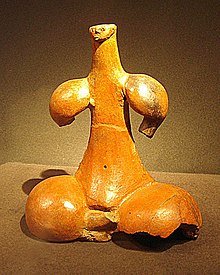User:Casaism/Tara Idol

The Tara Idol is a statuette made of red ochre and terracotta, associated with the worship of fertility by the ancient inhabitants of Gran Canaria (Canary Islands, Spain).[1] Its name originates from the pre-hispanic settlement of Tara in Telde, where it was supposedly found. According to a recent theory, the idol was found in Gáldar and not in Telde.[2]
Currently it is displayed in the Museo Canario in the city of Las Palmas de Gran Canaria. Its inventory number is 2899.
Description
[edit]The Tara Idol depicts a feminine figure in a sitting position. It has a long neck that stretches out to a small head with defined features. Its biceps and thighs are bulky and disproportionate to its size: 26 cm in height and almost 24 cm in width. The markings and incisions indicate the navel, vulva, nostrils, mouth and the eyes. Almost the entire idol was painted with red ochre. It was also polished to give it a shine, especially the parts that were not painted.
Discovery: controversies and inventory numbers
[edit]The idol was discovered by Dr Gregorio Chil y Naranjo during his excavations in September 1887. The identification and origin of the statuette is problematic and controversial. Celso Martín de Guzmán, an archeologist from Gáldar and the first director-general of the Canarian Government’s Department of Historic Heritage, claimed that the Palacio en el casco antiguo, also known as Palacio de los Guanarteme, in Gáldar could be the Idol’s place of origin. Today, you can find the Iglesia Matriz de Santiago de los Caballeros and the Museo y Parque Arqueológico Cueva Pintada there. A manuscript written by Chil was discovered, however, it did not provide any information on where the Idol was found, only that it was made in Gran Canaria. On November 1, 1995 La Gaceta de las Palmas published an article on this manuscript, which states that Chil probably donated the idol to the Museo Canario in 1901. However, there is no evidence in the records of the Museo Canario that it was a donation, but a legacy formalized in the testament of Chil. When reviewing the manuscript kept in the Museo Canario, Francisco Peinado Rodríguez discovered that in the second list of materials by Chil, specifically the ceramics, he had noted under the heading No. 68: "four pieces found in Gáldar that form an idol”. Based on the similar typology and size of the Tara Idol and the new fragments found in Gáldar, Peinado Rodríguez argues that the place of origin and the ceramic style would be similar.
According to the Museo Canario (as published in a catalogue in 2000) the most appropriate name for the statuette would be Chil Idol, as its origin is unproven.
In Chil’s manuscript the piece appears under the inventory number 249, in the inventory of Pérez Barradas (published in 1994) under the number 622, and the Museo Canario assigned it the number 2899.
See also
[edit]- Ídolo de Guatimac (Museo Arqueológico del Puerto de la Cruz, Tenerife)
Notes
[edit]References
[edit]- ^ El Museo Canario http://www.elmuseocanario.com/index.php/es/colecciones/arqueologia-de-gran-canaria/galeria-fotografica/91-figura-1-coleccion-de-arqueologia-de-gran-canaria?utm_content=bufferdb864&utm_medium=social&utm_source=twitter.com&utm_campaign=buffer. Retrieved 30 July 2017.
{{cite web}}: Missing or empty|title=(help); Unknown parameter|artículo=ignored (help) - ^ http://www.teldeactualidad.com/hemeroteca/articulo/geografia/2009/01/30/77.html.
{{cite journal}}: Cite journal requires|journal=(help); Missing or empty|title=(help)Missing or empty|title=(help) Category:Pages with citations lacking titles Category:Pages with citations having bare URLs
